When faced with a stream or river where fish cannot be seen emerging to the surface, it is important not to be fooled by the apparent calm. In fact, trout spend most of their time near the bottom waiting to catch prey as they pass by. In these situations, imitating food carried by the current below the surface becomes crucial, and fly-fishing with submerged techniques are the ideal answers.
Over the years, anglers have developed various methods of catching trout below the surface, perfecting the use of nymphs and emerging nymph imitations. With this article and others in a series dedicated to exploring these techniques, I will try to impart knowledge gained over the years, from the mental approach to take, to equipment and rigging, to specific lures.
La 'climbing nymph' represents one of the most typical fly fishing styles of the Italian school. It is a technique that finds its ideal context in fast and shallow torrential waters, which often have irregular currents interrupted by uncovered or submerged boulders. These environments, as well as the elusive character of brown trout, gave rise to a reflection and evolution of nymph fishing, which is still the preferred method of Italian anglers today.
The rising nymph is perfectly suited to these fast waters, where trout concentrate on food that is carried by the current below the surface. It is in fact during the upward movement of the nymph, which emulates the behaviour of insects in an emergency phase, that the most alert fish pounce on their prey. This approach makes it possible to explore the most difficult waters, where fish are not visible at the surface but feed below the water surface.
In decades past, Italian fly-fishing pioneers, who were inspired by the classic nymph fishing methods of authors such as F. Sawyer, G.E.M. Skues e C. Jardinethey began to develop a series of techniques that better suited the characteristics of our waters and the nature of brown trout. Although classic methods, such as the past nymph or the Sawyer methodwere already known, the specific needs of our aquatic environment have stimulated Italian enthusiasts to experiment with new solutions.
The introduction of the tungsten balls represented a major breakthrough. These weights, thanks to their high density, allow the artificial to sink quickly without increasing its volume too much, which makes the nymph more agile and effective in fast waters. The possibility of maintaining a small size without compromising sinking has led to greater accuracy in the simulation of the nymph rising to the surface, a very natural behaviour for fish.
Over the years, the 'climbing nymph' has seen a number of evolutions. Alongside it, other techniques have emerged such as the submerged to rise, the past nymph and the nymph with sinkereach of which has its specific uses and benefits. The technique of climbing nymphHowever, it remains one of the most popular, precisely because of its ability to adapt to a variety of environmental conditions.
The movement of the nymph to ascend It emulates the rise of a larva preparing to emerge, a behaviour that irresistibly attracts trout. The key to this technique is the use of lures that rise slowly to the surface, through a retrieve that often occurs in sections, so as to simulate the natural movement of the nymph. In cold periods, however, trout will be reluctant to rise to the surface to eat our nymphs, so we must try to work them as close to the bottom as possible.
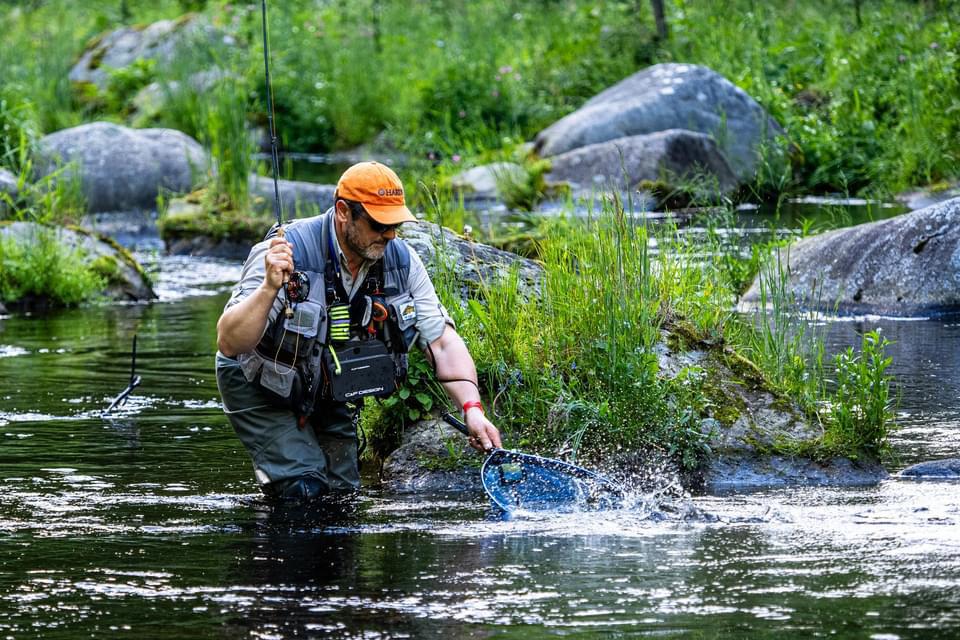
Rods suitable for nymph fishing should be between 9 and 11 feet in length, being light and particularly sensitive. It is preferable to choose models with a low tail weight, generally between #2 and #4. This characteristic is fundamental for perceiving even the most delicate bites, which are often not visible but only noticeable through the sensitivity of the rod. I recommend the use of a 9′ only in the case of small streams.
One of the most common obstacles for those coming from dry fishing is the choice of rod; not all rods designed for dry fishing are suitable for nymphing, even if the length may seem adequate. The action of the rod, whether tip or parabolic, is a matter of personal preference.
In recent years, the market has introduced competition-specific equipment for nymphing, including high quality rod models at affordable prices, making this technique more accessible to all anglers.
In nymph fishing, classic casting is almost non-existent, so an extremely light and under-tuned rat-tail is preferred to the rod. Very thin tails reduce the overall weight of the system, allowing greater sensitivity in the presentation of the nymph. The innovative 0.55 mm level line tails are proof of this. Designed for 'flush fishing', these tails being extremely light allow you to fish even long distances without their weight dragging the nymphs towards you.
It is advisable to create a loop at the end of the tail to connect the end, avoiding overly rigid joints that could compromise the naturalness of the fishing action. I make the final loop by stripping 4 cm of the tail, forming a loop and sewing it with Kevlar. After that I make a binding that covers the entire seam and cover it with a flexible glue like 'Artiglio glue'.
The leader plays an important part in the practice of this technique, as it is responsible for transferring the sensations and guiding our flies through the water and into the cast. We can use a 220 cm long knot-typed leader. Its tapering allows for great precision, which is an undeniable advantage for casting nymphs exactly in the desired places, especially considering that we face waters with many currents and restricted fishing areas with shallow water, where sometimes the first cast is a winner, so it is very important that it is well executed and precise.
The quality that a nylon monofilament for this type of end must have is softness. I start with a diameter that is not very large, in order to remain in line with the concept of sensitivity: light and sensitive rod, light tail and fine end, as the whole must have its own undeniable harmony.
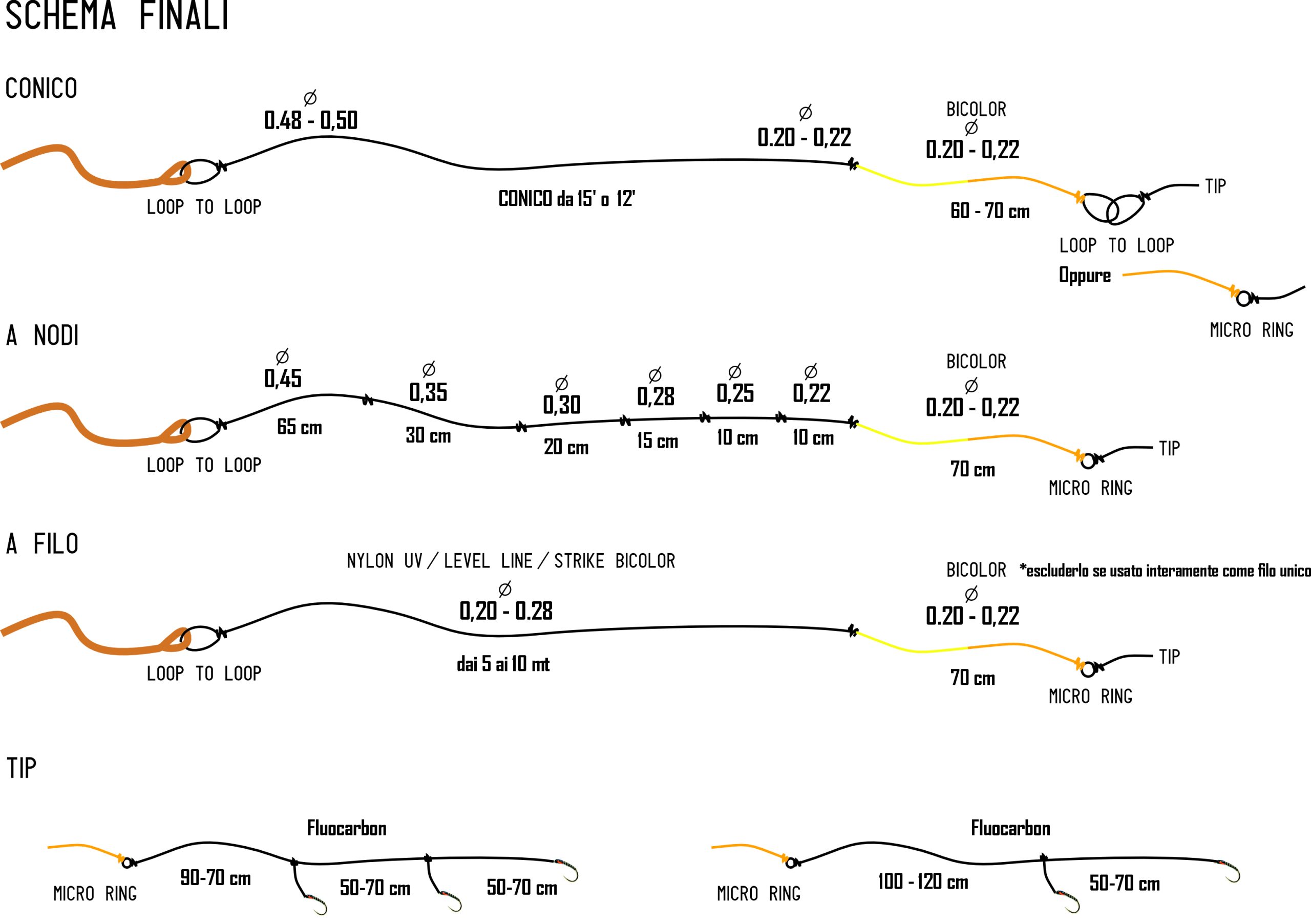
The body of the finish ends with a buttonhole or micro ring to which I tie the tip, which will vary in diameter and length depending on the conditions and needs of the river I will tackle.
I use the first piece of tip, which goes from the buttonhole to the fly rod, to shorten or lengthen the end. In shallow and clear water conditions I prefer to lengthen this length, as this allows me to fish longer and have a softer pose. For the tip I use fluorocarbon and the overall length is between 1.80 and 2.10m. A very simple way to make a standard tip is to measure the length from the left shoulder to the right hand, which will be about 100/120 cm long, while for the final tip I measure the distance from the right shoulder to the right hand, which is about 70 cm. In the event that three lures can be used, I make three 70-cm-long sections.
Another end that I also recommend for competitions is the 12′ conical end with a 0.20/0.22 to which a 60/70 cm two-colour strike indicator is attached. You can create a loop with a Perfect Loop knot or use a micro ring to join it to the tip.
Much used lately as a terminal is a simple 0.20/0.28 diameter wire, which can be a UV nylon, a Tenkara level line or simply the bicolour strike indicator, the length can vary from 5 to 10 metres. I believe, however, that using a length greater than 10 metres is useless and unproductive for fishing purposes.
In upstream nymph fishing, two nymphs are generally used, spaced about 60-70 cm apart. If placed too close together, they can create problems when casting and compromise the naturalness of the presentation.
The nymphs used are weighted, using lead wrapped around the hook or brass or tungsten balls depending on the depth and speed of the current. Tungsten is the most popular material due to its high sinking capacity, but it is important to dose the weight as an excess may make the fishing action less effective.
There are nymphs of all shapes and colours, divided between realistic imitations and fantasy models. Generally, hook sizes ranging from 12 to 18, varying the weight of the pellet to suit the river conditions. The introduction of synthetic materials has made modern nymphs brighter and flashier, although this feature seems to attract anglers more than fish.
One of the most relevant innovations is the hot spotor brightly coloured details such as coloured balls, neon collars, neon tails like Red Tag, which create colour contrasts and stimulate the fish's aggressiveness. However, the basic structure of the nymphs has not changed much compared to traditional models, made from natural materials such as hare's ear, pheasant tail and rabbit or squirrel dubbing. The latter, in fact, continue to be extremely effective.
Rather than recreating an exact imitation of the nymphs in the river, the main objective is to offer a generic and well-presented imitation. The choice of nymph therefore depends above all on its structure: the materials influence the way it sinks and works in the water. For example, a nymph with hairy materials will sink more slowly than a more slender and compact one, making it more suitable for long passes in waters with moderate currents. One of the innovations of recent years are the perdigon. They are nymphs made of synthetic materials such as Glitter Thread, Body Fly, Floss, Peacocked Quill or simple mounting wire painted with UV glue. This allows the nymph to sink very quickly as there is no material that can cause friction outside the silhouette of the nymph.
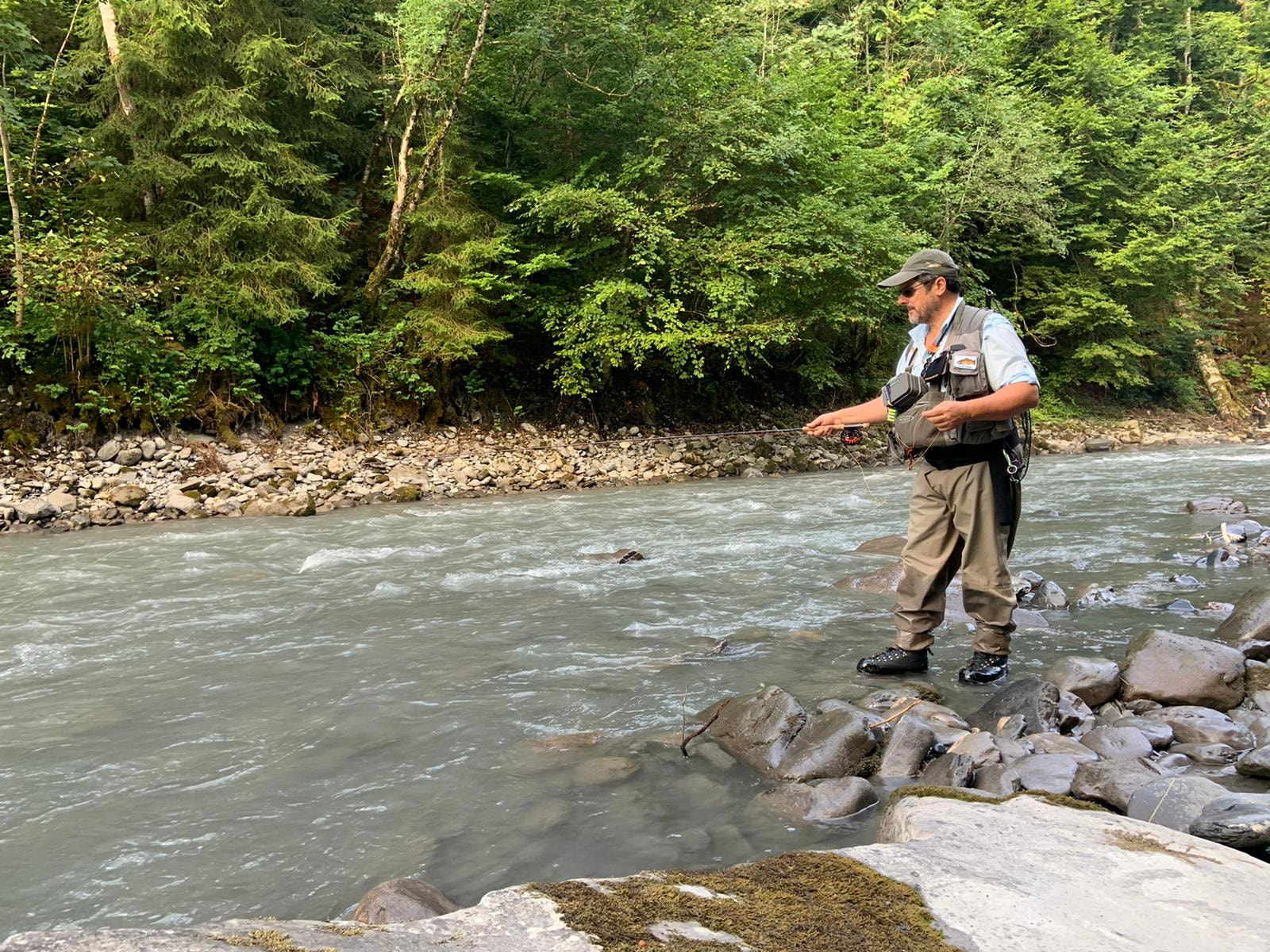
In nymph fishing, sensitivity is everything. It is essential to sense where the flies are and how they are working. This information is transmitted by the equipment, the position of the leader and tail and the vibrations on the rod. With experience, the angler learns to interpret it and intervene when necessary.
This technique falls into the category of short nymphing, where the lures are worked a short distance from the angler. A minimum of tail off the rod is used, and the casting consists essentially of tipping the line, performed with wrist and forearm. The key is to position yourself correctly, going up the river and tackling the fishing areas from below.
Once the flies touch the water, the rod is lifted to pull the artificials in and control their descent. If left free, the leader and nymphs would be dragged by the current, reducing their effectiveness.
The angler must adjust the tension on the rod according to the activity of the fish: if the fish is not very active, the flies should be allowed to descend gently; if it is aggressive, more contact with the lures can be maintained.
It is also crucial to maintain visual contact with the beacon at all times, as any anomaly in its movement may indicate a bite. Even the slightest slowdown or lateral deviation must be interpreted as a possible attack.
The ferrata action must be quick and decisive, but without excessive jerking. A good trick is to tilt the rod slightly downstream, so as to exert an effective pull without creating unnecessary resistance that could cause the fish to dislodge.
As I approach the river, I tend to position myself strategically so as not to be too visible to the fish. I usually come from behind and position myself a little downstream and to the side, trying not to disturb the environment too much. The first cast is always the most important: I try to cover the entire fishing area, starting with the nymphs at the highest part of the current and letting them go down naturally, following the flow. The first cast is often the decisive one, as a second cast could create disturbance and scare off the fish. If the fishing area is large, I always start by casting close to the bank and then gradually move closer and concentrate on the higher waters towards the middle of the river. Often you 'walk on fish' and see them run off in all directions, do you know why? Because you have not fished the sub-bank, which is often strategic for a good catch. Fish prefer to stay, often times, near the bank because the current, although obviously less, brings them food anyway and, not to be underestimated, saves them energy, which is crucial for their survival!
Of course, the season also has a great influence on the location of the fish. Depending on the time of year, the fishing spots change: in summer it is best to concentrate on the middle and end zones of the current, where the water is shallower and more oxygenated, while in spring and autumn the fish are more frequently found in deeper water, where the current is slower and perhaps close to a burrow. After a few passes, I move on to the next spot, always following a logical path in my movements. I often move across the river diagonally, gradually moving upstream and then back, creating a kind of invisible 'zig-zag' along the water course.
Once the nymphs touch the water I concentrate on bringing the tail end into shot. I gently raise the rod to bring the flies down at the same speed as the current by slowly backing up and bending my arm while maintaining the natural arc between the tail and the line. I continue to move my torso so that the rod is perpendicular to the direction of the flies. This is the final area of my pass. The position of the rod together with the tension of the tail and the finish helps me to understand how the nymphs are working. If the rod is high, with the tail and finish well tensioned, it means that the flies are very much in contact with the current and are probably moving upwards. Conversely, if the rod is low and moving faster downstream than the flies with the arc formed by the tail and the leader clearly visible, it means that the nymphs are freer in the current. In this case, I have to pay attention to their weight so that they do not get stuck on the bottom as they travel in the current. In the case of windy conditions, I always recommend lowering the rod considerably to avoid forming a large belly of the tail and thus losing contact with the nymphs.
When approaching a river for the first time, it is essential to try to understand how the fish is feeding. We have said that it can be very active and moving or stationary on the bottom. This is why it is important to do some trials by varying the way you work the nymphs so that you understand from the very first catch what the fish's behaviour is at that moment. Each catch provides valuable information about the behaviour of the fish, where they are, what kind of movement they prefer and what they are eating.
Wild fish in a river tend to behave similarly, so being able to identify where the fish are stationed is crucial. Understanding how they are eating is just as important: replicating the type of movement that led to the capture at that moment can make all the difference in subsequent catches. Often a catch made by chance can prove extremely useful by providing insights into the behaviour of the fish.
In my opinion what they are eating is less of an issue even though sometimes one fly may be particularly catching than others for reasons that are not always clear to us. In such cases it can be useful to mount two identical flies.
There are also some small tricks that sometimes make a big difference. One example is what we might call an 'invitation': while passing, you make small upward strokes with the rod, causing the nymphs to make a hint of ascent and descent. The fish seeing a prey trying to escape may promptly react with an attack. Another trick is the hold at the end of the pass: before reeling in, stop the rod for a few seconds, thus generating an upward movement of the flies that will rise to the surface. Even an extra moment of waiting can sometimes be decisive for a successful catch.
At the bottom of the page you will find the Comments! 😊 Here you can actively participate by leaving your opinion, asking questions or requesting further information and curiosities. I look forward to reading you!

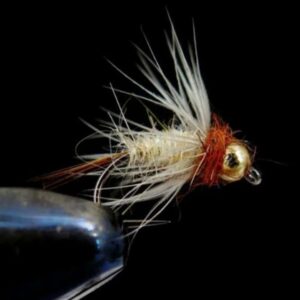



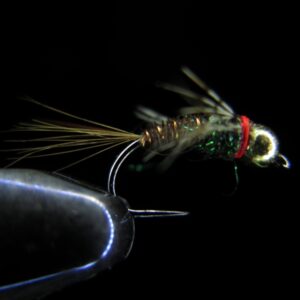
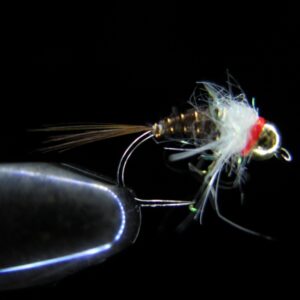







One Response
Thank you for reading this article! 😊 If you have any questions or would like to share your opinion, please leave a comment below. I'm curious to know what you think! 👇